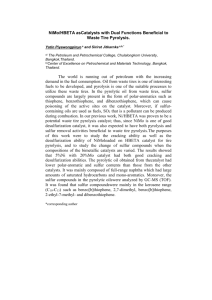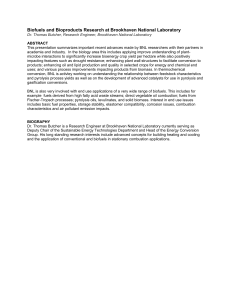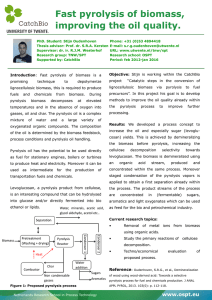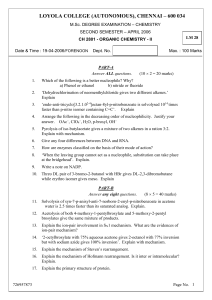IJMRA-3543
advertisement
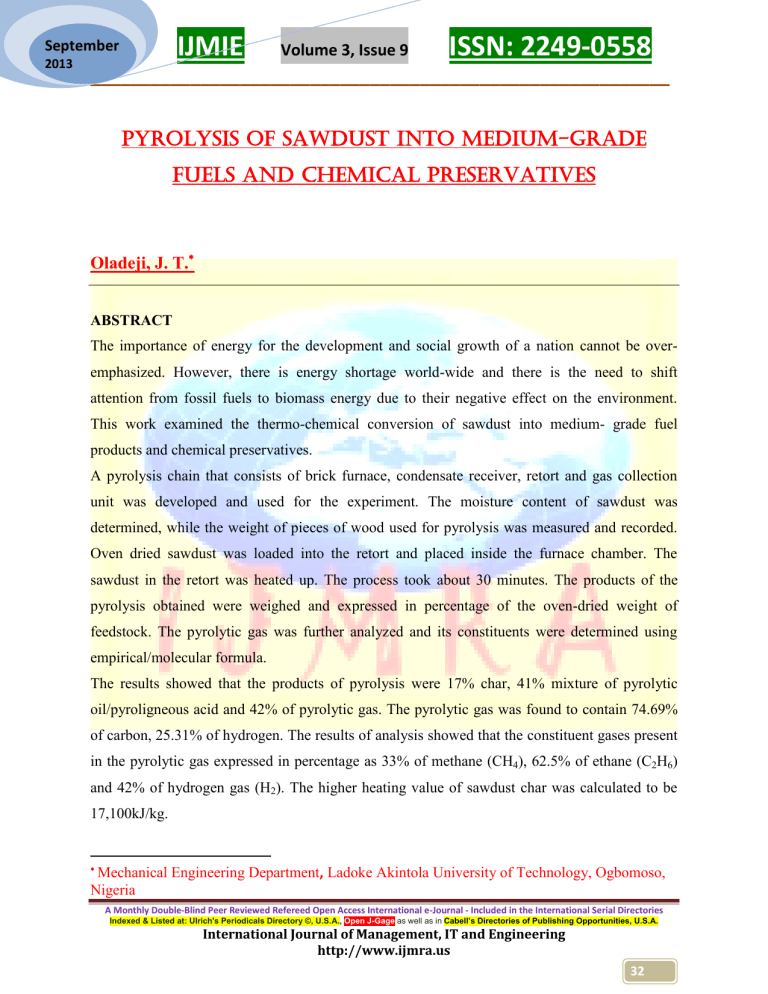
IJMIE September 2013 Volume 3, Issue 9 ISSN: 2249-0558 __________________________________________________________ PYROLYSIS OF SAWDUST INTO MEDIUM-GRADE FUELS AND CHEMICAL PRESERVATIVES Oladeji, J. T. ABSTRACT The importance of energy for the development and social growth of a nation cannot be overemphasized. However, there is energy shortage world-wide and there is the need to shift attention from fossil fuels to biomass energy due to their negative effect on the environment. This work examined the thermo-chemical conversion of sawdust into medium- grade fuel products and chemical preservatives. A pyrolysis chain that consists of brick furnace, condensate receiver, retort and gas collection unit was developed and used for the experiment. The moisture content of sawdust was determined, while the weight of pieces of wood used for pyrolysis was measured and recorded. Oven dried sawdust was loaded into the retort and placed inside the furnace chamber. The sawdust in the retort was heated up. The process took about 30 minutes. The products of the pyrolysis obtained were weighed and expressed in percentage of the oven-dried weight of feedstock. The pyrolytic gas was further analyzed and its constituents were determined using empirical/molecular formula. The results showed that the products of pyrolysis were 17% char, 41% mixture of pyrolytic oil/pyroligneous acid and 42% of pyrolytic gas. The pyrolytic gas was found to contain 74.69% of carbon, 25.31% of hydrogen. The results of analysis showed that the constituent gases present in the pyrolytic gas expressed in percentage as 33% of methane (CH4), 62.5% of ethane (C2H6) and 42% of hydrogen gas (H2). The higher heating value of sawdust char was calculated to be 17,100kJ/kg. Mechanical Engineering Department, Ladoke Akintola University of Technology, Ogbomoso, Nigeria A Monthly Double-Blind Peer Reviewed Refereed Open Access International e-Journal - Included in the International Serial Directories Indexed & Listed at: Ulrich's Periodicals Directory ©, U.S.A., Open J-Gage as well as in Cabell’s Directories of Publishing Opportunities, U.S.A. International Journal of Management, IT and Engineering http://www.ijmra.us 32 IJMIE September 2013 Volume 3, Issue 9 ISSN: 2249-0558 __________________________________________________________ From the study, it can be concluded that, sawdust lent itself easily to process of pyrolysis and had been successfully pyrolyzed into medium-grade biomass fuels. The conversion efficiency was 89.19%. Keywords: Pyrogas, pyroligneous acid, pyrolysis, sawdust, tar oil 1.0 Introduction In the world today, energy and consumption are enormously increasing apparently due to rapid increase in population and technological advancement. There is the need to generate alternative source of energy other than fossil fuels, which are the major sources of the energy for most operations. More importantly, because of the problems associated with the usage of petroleum based products, which include among others, high cost, scarcity, depletion and pollution of environment, more attention should be paid to the generation of renewable energy. One of the most important energy sources for mankind is biomass which is referred to all organic materials particularly wood and agricultural residues. It accounts for approximately 14% of total energy consumption in the world (Kaygusaz and Turker, 2002). This has necessitated the need to improve on the use of loose agro-wastes such as sawdust, rice husk and so on as alternative sources of energy generation. A large amount of agro-wastes are generated in Nigeria, however, it is very unfortunate that despite generation of large amount of agro wastes in the country, much is not made use of them and their potentials are yet to be fully tapped for energy generation (Olorunnisola, 2007; Oladeji, 2011). In Nigeria, the felling of trees for fuel has led to the increase in desertification of the northern parts of the country, and progressive changing of the southern rain forest zone into derived savannah (Oladeji, 2012). Wood is also used extensively as timber, sawdust and wood fragments made by saw in cutting. They are unavoidable in all type of primary and secondary wood processing. All over Nigeria, heaps of sawdust are a familiar sight at wood processing plants (sawmills).These heaps are disposed by the open air burning, which contributes to atmospheric pollution, but more than that, the burning or decomposition is a waste of available energy (Jekayinfa and Scholz, 2009). Most of these wastes contain enormous amount of energy (Jekayinfa and Omisakin, 2005). Sawdust, if properly harnessed and managed will go a long way to alleviate some of the energy crises being experienced at present. Sawdust may be converted to products of medium-grade fuel and chemical preservative through the process known as pyrolysis. Pyrolysis has been described as thermal breakdown of biomass in the absence A Monthly Double-Blind Peer Reviewed Refereed Open Access International e-Journal - Included in the International Serial Directories Indexed & Listed at: Ulrich's Periodicals Directory ©, U.S.A., Open J-Gage as well as in Cabell’s Directories of Publishing Opportunities, U.S.A. International Journal of Management, IT and Engineering http://www.ijmra.us 33 September 2013 IJMIE Volume 3, Issue 9 ISSN: 2249-0558 __________________________________________________________ oxygen to produce solid residue, condensable organic liquid and non-condensable gas (Fapetu, 2000a). Pyrolysis is of relevance in tackling energy problem and occurs under pressure and at operating temperature above 4500C (Bridgewater, 2002). Few researchers had worked on pyrolysis of agro-residues. Examples of agro- residues studied are maize cob (Bamigboye and Oniya, 2003), wood residues (Fapetu, 2000b), oil palm waste (Guo and Lua, 2001), and so on. The aim of this work was to determine the products from the pyrolysis of sawdust. 2.0 Materials and Methods Sawdust from “iroko” specie that was utilized for this experiment was collected from wood processing closed to the university. The sawdust was sun-dried until stable moisture content was obtained. The sample was oven-dried at a temperature of 103±2OC and the moisture content was determined according to the procedure highlighted in ASAE S 269.4 To facilitate the process of pyrolytic conversion of sawdust, a simple pyrolysis chain was set up and developed .It consists of retort, brick furnace, condensate receiver and gas collection unit (Plate 1 and Fig.1). All the materials used were sourced locally and they were affordable. The sawdust sample, which weighed 0.9 kg, was put inside the retort and the inlet of the retort was made air tight. The retort was placed in a brick furnace and 0.7 kg of pieces of firewood was packed closely around the retort and small quantity of kerosene was sprinkled on the firewood. The fire produced was used to generate the heat needed for the pyrolysis process. The process took 30 minutes for complete pyrolytic conversion to take place. The pyrolysis chain was left to cool in the natural air after which the pyrolysis products were collected, weighed and recorded. The pyrogas, which was collected in a cylinder, was taken to the laboratory for further analysis, where the composition of the constituent gases was determined through empirical/molecular formula. A Monthly Double-Blind Peer Reviewed Refereed Open Access International e-Journal - Included in the International Serial Directories Indexed & Listed at: Ulrich's Periodicals Directory ©, U.S.A., Open J-Gage as well as in Cabell’s Directories of Publishing Opportunities, U.S.A. International Journal of Management, IT and Engineering http://www.ijmra.us 34 September 2013 IJMIE Volume 3, Issue 9 ISSN: 2249-0558 __________________________________________________________ Plate 1: A Pictorial View of Pyrolysis Set-up Figure 1: Isometric View of Pyrolysis Set-up 3.0 Results and Discussion The results of pyrolysis of sawdust are as presented in Tables 1-4. The pyrolysis of sawdust yielded the following products: charcoal, mixture of pyrolytic oil/pyroligneous acid and pyrolytic A Monthly Double-Blind Peer Reviewed Refereed Open Access International e-Journal - Included in the International Serial Directories Indexed & Listed at: Ulrich's Periodicals Directory ©, U.S.A., Open J-Gage as well as in Cabell’s Directories of Publishing Opportunities, U.S.A. International Journal of Management, IT and Engineering http://www.ijmra.us 35 IJMIE September 2013 Volume 3, Issue 9 ISSN: 2249-0558 __________________________________________________________ gas. The average percentage weight of the charcoal left in the retort was 16%, while the percentage of pyrolytic oil/pyroligneous acid and pyrogas were 41% and 42% respectively. Table 1: Composition of Products of Pyrolysis of Sawdust Parameters Weight of oven-dried sawdust (kg) Moisture content of sawdust (%) Weight of firewood used (kg) Weight of char obtained (kg) Weight of mixture of oil and pyrolytic acid (kg) Weight of gas (kg) Higher Heating Value (kJ/kg) Conversion Efficiency (%) Value 0.9 10.56 0.7 0.144 0.369 0.378 17,100kJ/kg 89.19 Table 2: Products of Pyrolysis expressed as Percentage (%) of Input Feedstock Products Char yield Mixture of tar oil/pyroligneous acid Pyrogas Percentage Composition (%) 17 41 42 Table 3: Constituents of Pyrogas Constituents Percentage (%) 74.69 25.31 Carbon Hydrogen Table 4: Percentage (%) Composition by volume of gases formed Gas Ethane Hydrogen Methane Chemical formula C2H6 H2 CH4 Percentage composition by volume (%) 62.5 4.2 33.3 The result shows that pyrolytic gas has the highest yield of 42%, followed by pyrolytic oil/pyroligneous acid (41%) with char yield (charcoal) having the least yield of 17 %.The mean char yield of the 17% deviates from the values obtained for the char yield of char from the A Monthly Double-Blind Peer Reviewed Refereed Open Access International e-Journal - Included in the International Serial Directories Indexed & Listed at: Ulrich's Periodicals Directory ©, U.S.A., Open J-Gage as well as in Cabell’s Directories of Publishing Opportunities, U.S.A. International Journal of Management, IT and Engineering http://www.ijmra.us 36 IJMIE September 2013 Volume 3, Issue 9 ISSN: 2249-0558 __________________________________________________________ pyrolysis of palm kernel, ekki wood and coconut shell, where values were obtained as 28.07%, 25.07% and 29.62% respectively (Fapetu, 2000b). However, the yield of pyrolytic oil /pyroligneous acid and pyrogas compares well with findings of (Bamigboye and Oniya, 2003), where the percentage yields of tar oil/pyroligneous acid and pyrogas were 38.47% and 33.82% respectively. The constituents of pyrogas were 74.69% carbon and 25.31% hydrogen. Further analysis reveals that the pyrogas consists of three major gases which are methane (CH4), ethane (C2H6) and hydrogen (H2). Their percentage composition by volume in the order listed above is 33%, 63.5% and 4.2% respectively. The conversion efficiency was calculated to be 89.19 %. The results of this work when compared with the pyrolysis of other agro-wastes by few researchers highlighted above show that the products of pyrolysis depend on the type of biomass feedstock, its chemical constituents, quality and operating conditions. The higher heating value of char product was found to be 17,100kJ/kg and could be used for traditional and cottage industrial purposes as in domestic cooking and as fuel in open earth furnace for blacksmithing and goldsmithing operations (Ogunsola and Oladeji, 2009). The pyrolytic gas could be used as household cooking gas and as fuel for gas lamps (Bamigboye and Oniya, 2003). The pyrolytic gas could further be used as fuel in the internal combustion engines (Bridgewater, 2002). Conclusions From the results obtained in this study, the following conclusions were drawn: i. The study reveals, that sawdust, which is a wood waste product, which ordinarily may be used as low-grade fuel by direct burning can be pyrolyzed into much higher-grade fuels, which are char, pyrolytic oil and pyrolytic gas. ii. Sawdust has a gas yield of 42% of the feedstock, with a char yield of 17% with higher heating value of 17,100kJ/kg and a yield of 41% for the mixture of tar oil and pyroligneous acid. iii. The conversion efficiency which is 89.19% is good A Monthly Double-Blind Peer Reviewed Refereed Open Access International e-Journal - Included in the International Serial Directories Indexed & Listed at: Ulrich's Periodicals Directory ©, U.S.A., Open J-Gage as well as in Cabell’s Directories of Publishing Opportunities, U.S.A. International Journal of Management, IT and Engineering http://www.ijmra.us 37 IJMIE September 2013 Volume 3, Issue 9 ISSN: 2249-0558 __________________________________________________________ References ASAE S 269.4 (2003) Cubes pellets and crumble definitions and methods for determining density, durability and moisture content 567-569 St.Joseph Mich. USA. Bamigboye, A.I., and Oniya, O., (2003) “Pyrolytic Conversion of Corncobs to Medium- Grade Fuels and Chemical Preservatives” FUTAJEET Vol.3 No. 2 pp50-53 Bridgewater, A.V., (2002) An introduction to fast pyrolysis of biomass for fuel and chemicals in the fast pyrolysis of biomass: - A handbook CPL Press, Newbury, U.K. Fapetu O.P., (2000a) “Management of Energy from Biomass” Nigerian Journal of Engineering Management Vol.1 No.1 pp14-19 Fapetu, O.P., (2000b) “Production of charcoal from tropical biomass for industrial and metallurgical process” Nigerian Journal of Engineering Management Vol.1 No. 2 pp 34 -37 Guo, J. and Lua, A.C., (2001) “Kinetic study on pyrolytic process of oil palm solid waste using two step constructive reaction model” Biomass and Bioenergy Vol. 20 pp223 - 225 Jekayinfa, S. O., and Scholz, V., (2009) “Potential Availability of Energetically Usable Crop Residues in Nigeria” Energy Sources, Part A, Vol. 31: 687-697. Jekayinfa, S.O., and Omisakin, O.O., (2005) “The energy potential of some agricultural wastes as local fuel materials in Nigeria” Agricultural Engineering International: the CIGR Journal of Scientific Research and Development Vol. 111 Manuscript EE 05 033:10 E- Kaygusaz, K., and Turker, M.F., (2002) “Biomass and Energy Potential in Turkey” Biomass and Bioenergy, 26:661- 678 Ogunsola, A. D., and Oladeji, J.T. (2009) “The Development of a Pyrolysis Unit for Conversion of Corncobs to Improved Biomass Energy” IJAAAR Vol.5 No. pp 17-21. A Monthly Double-Blind Peer Reviewed Refereed Open Access International e-Journal - Included in the International Serial Directories Indexed & Listed at: Ulrich's Periodicals Directory ©, U.S.A., Open J-Gage as well as in Cabell’s Directories of Publishing Opportunities, U.S.A. International Journal of Management, IT and Engineering http://www.ijmra.us 38 IJMIE September 2013 Volume 3, Issue 9 ISSN: 2249-0558 __________________________________________________________ Oladeji, J.T. (2011) “The Effects of Some Processing Parameters on Physical and Combustion Characteristics of Corncob Briquettes,” An Unpublished Ph.D Thesis, Department Mechanical Engineering, Ladoke Akintola University of Technology, Ogbomoso, Nigeria of Oladeji, J.T., (2012) “Comparative Study of Briquetting of Few Selected Agro-Residues Commonly Found in Nigeria” Pacific Journal of Science and Technology, 13(2):8086 Olorunnisola, A.O., (2007) “Production of Fuel Briquettes from Waste Paper and Coconut Husk Admixtures” Agricultural Engineering International. the CIGR E- Journal of Scientific Research and Development Manuscript E OI 011 Vol..111 A Monthly Double-Blind Peer Reviewed Refereed Open Access International e-Journal - Included in the International Serial Directories Indexed & Listed at: Ulrich's Periodicals Directory ©, U.S.A., Open J-Gage as well as in Cabell’s Directories of Publishing Opportunities, U.S.A. International Journal of Management, IT and Engineering http://www.ijmra.us 39
